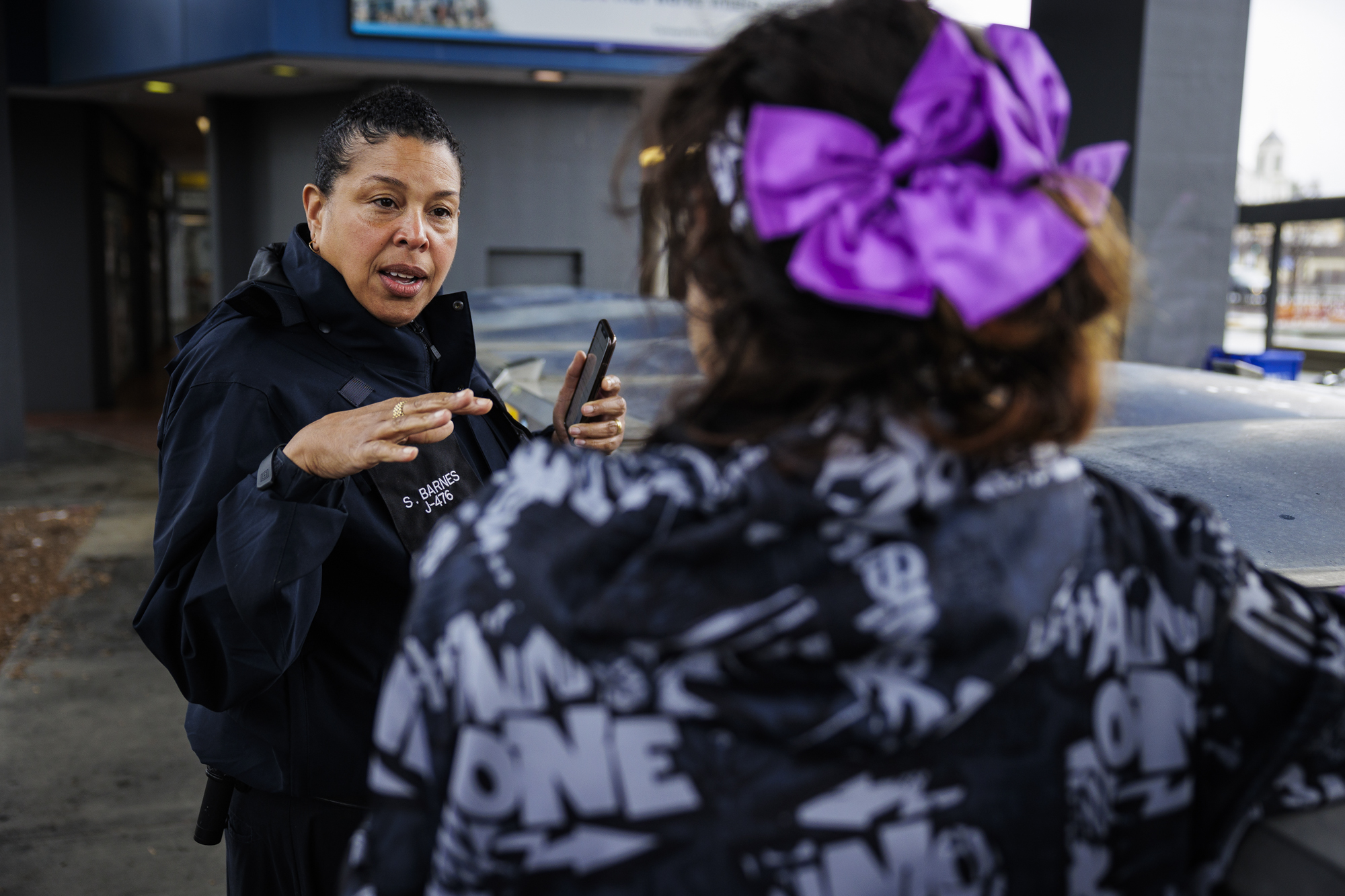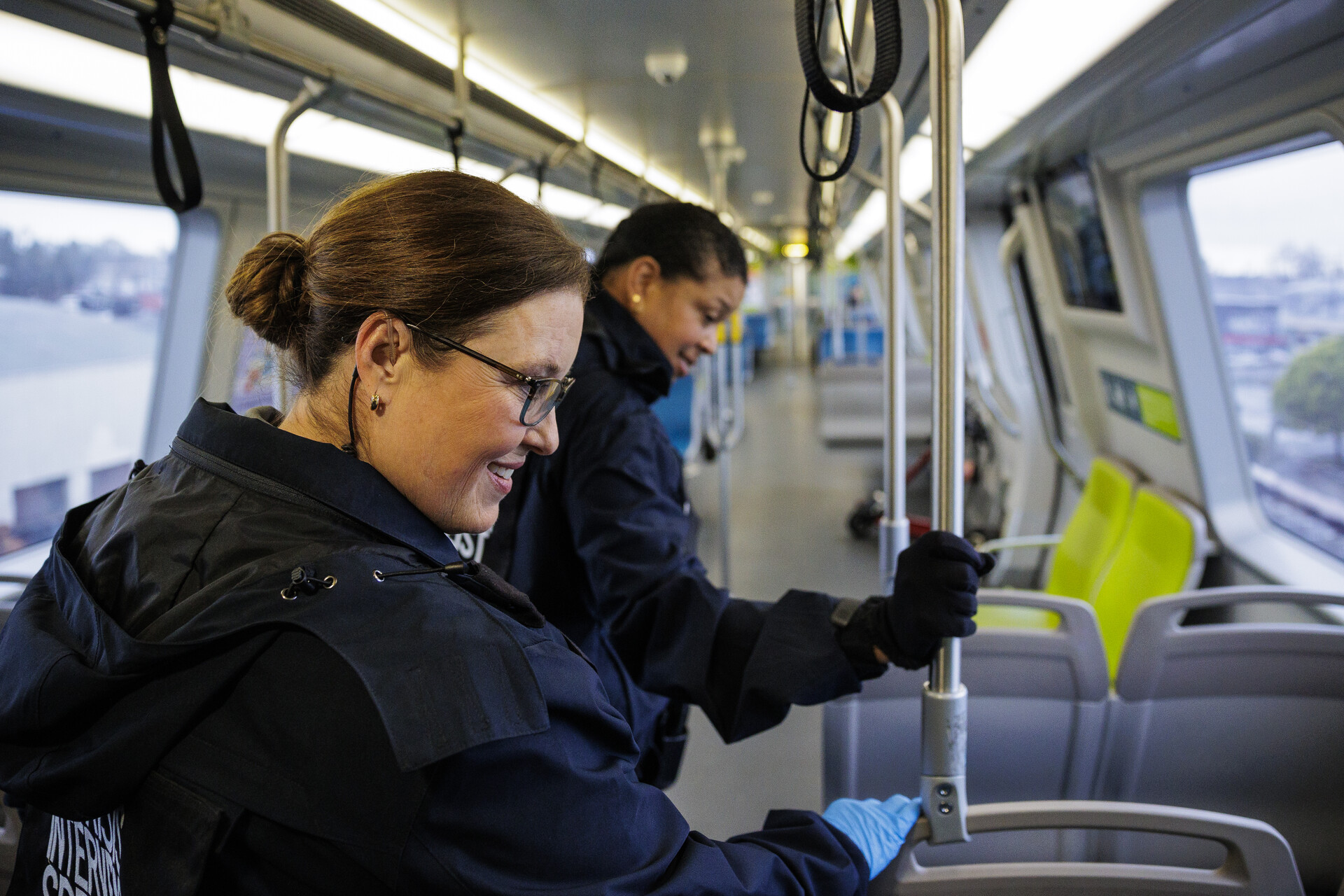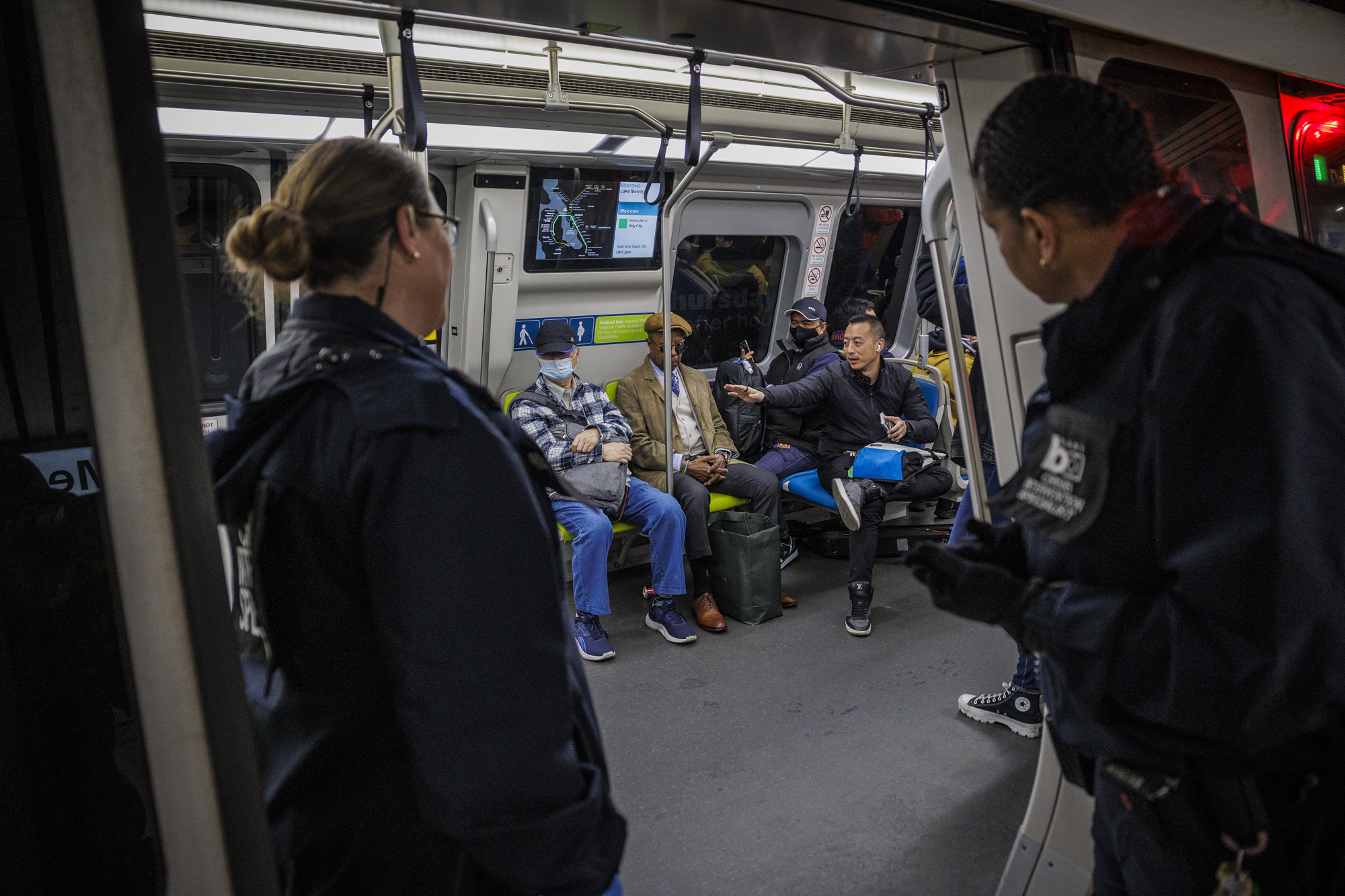On a recent rainy morning, Stephine Barnes paces slowly through a covered outdoor walkway off the main entrance of the San Leandro BART station.
“People like to camp out here because you have shelter. There’s no rain, it’s dry. So people just find little nooks and crannies,” Barnes says, surveying the area. “It’s usually where we find a lot of people in the wee hours of the morning, sleeping, camped out, wandering around.”
Barnes is a BART crisis intervention specialist, and her job entails seeking out and offering help to the many people in the sprawling transit system struggling with lack of shelter, mental health problems or addiction. She and her partner for the day, Natalie Robinson, are part of the agency’s ambitious new efforts to address a slew of human crises that show up on BART’s trains and platforms every day — without involving the police.
They spot a young woman with glasses and a purple bow in her hair who is hastily pulling belongings from a bike locker. Two roller bags, a dirty blanket and a ragged stuffed octopus are among the random array of possessions splayed on the ground around her.
Barnes and Robinson approach cautiously, mindful of a large Rottweiler sitting nearby.
“We like to connect people with resources,” Robinson says. “So if you have a need for shelter, housing, anything like that, you can let us know.”
The woman, who gives her name as Cat, seems tentative but receptive. She tells them that she and her boyfriend arrived recently from Southern California. They had been living in their car and storing their belongings in the bike locker. But BART police had just ordered them to clear out.
Cat nods to the dog, which sports a black-and-white smiley face bandana around its neck. “That’s Einstein,” she says. “He’s our son.”
“Oh, my goodness, you’re just a sweetheart,” Barnes exclaims, patting the dog’s head.

She tells Cat to take her time retrieving her belongings, and emphasizes that she and Robinson are not police officers and aren’t there to pressure her to leave.
“If you guys are interested in getting on the list for permanent housing in Alameda County, there’s a place called Hedco in Hayward,” Barnes tells her. “You can get coffee in the morning and all that kind of stuff. And then they put you in line on how to get these resources for housing and all of those things Alameda County offers.”
Robinson explains how to get there and hands Cat her card, telling her to call if she needs anything.
“I’m really bad with resources, honestly. So this is great,” Cat says, stuffing the card in her jacket pocket and continuing her hurried packing.
“You don’t have to be out here forever,” Robinson says as she and Barnes wish Cat luck and head back toward the station.
They’ll probably never know if she follows through.
“It varies widely,” Robinson says. “We could bring someone to a resource, and they literally don’t walk in the door, or we connect somebody, and they follow all the way through.”
‘Customer service on steroids’
In 2021, Barnes and Robinson, both seasoned BART employees, were among the first to join the crisis intervention team, now a 20-member crew dispatched throughout the 50-station transit system to offer help to people who appear to be overtly in need of it.
Finding that population has gotten a good deal easier in recent years, amid a discernible uptick in the number of people on BART’s trains and platforms experiencing homelessness or suffering from serious mental health issues — a trend that mirrors the overall surge in the Bay Area’s unhoused population since the start of the pandemic.
BART realized “a lot of the problems that were happening outside the station were coming inside the station,” says Barnes, 53, who was a station agent for 27 years, most recently at the Coliseum station in Oakland, before taking this job. “And, of course, as an agent, you see that firsthand.”
BART’s boots-on-the-ground outreach approach, launched in the depths of the pandemic, marks a notable foray into social services for an agency whose main objective has always been getting people from point A to point B.
The effort comes as BART struggles to recoup ridership, which still hovers at just over 40% of pre-pandemic levels, and as riders consistently say in surveys that they’re most dissatisfied with how the agency addresses homelessness.

Those factors have prompted BART’s leaders to ratchet up funding for crisis intervention and related services — to the tune of $11 million last year, according to the agency’s 2023 homeless action plan.
“People have seen a need for something different than what everyone was doing before, which was, ‘Call the police, call the police, call the police,’” says Barnes, who describes her job as “customer service on steroids.”
Most jobs at BART have existed since the agency started running trains more than 50 years ago, she notes.
“There was nothing, though, that really addressed the mental health component or the homelessness crisis that we’re experiencing in the Bay Area,” Barnes says. “So when I first read [about the job], I thought, ‘Wow, this is like the next-level customer service.’ Because some customers need more help than just buying a Clipper Card.”
The CISes, as they’re called, operate under the auspices of BART’s Police Department. But they wear distinctive, labeled uniforms and roam the stations and trains of their assigned zone in pairs, unaccompanied by sworn officers.
They also have no enforcement power and don’t carry any weapons.
They’re armed, instead, with latex gloves, Narcan — used to reverse opioid overdoses — and police radios in the event they need backup. And they use electronic notepads to document and tally their interactions, data the agency hopes will eventually demonstrate the still-undetermined effectiveness of the program.
Some CISes, like Robinson, 49, who worked as a BART police dispatcher for 16 years, also load their pockets with snacks to hand out. Others carry extra pairs of clean socks.
Much of the help CISes offer comes in the form of referrals to a collection of social service and mental health nonprofits sprinkled throughout BART’s five-county service area.
“We get to do God’s work out here,” Robinson says. “We’re helping people who are unhoused, who have substance-abuse issues, mental health issues. And being able to connect them to the proper service — those who are willing to make changes in their life — it’s just really rewarding.”
Signs of distress
On this morning, Barnes and Robinson are about midway through an 8-hour shift, one that began at 5 a.m. and has taken them back and forth multiple times across their zone, from San Leandro to Lake Merritt stations. Much of that is spent patrolling train cars and platforms, searching for telltale signs of distress.
“We pay attention to maybe some drug paraphernalia, someone who might be passed out, and check on their welfare,” Robinson says. “And then we’re also patrolling stations and just interacting with the public and building relationships with individuals that we see on a repeat basis.”
BART station agents and train operators can reach out to the CISes for help dealing with difficult but non-threatening situations, Barnes says. Passengers can also now call BART police to request help from a non-sworn officer, and dispatchers are authorized to reroute certain 911 calls to them.

“We can be more accessible to the public than the officers can. They’re responding to emergencies, they’re responding to fights, they’re responding to someone with a weapon,” Barnes says. “But we can take the time out. If you need to talk to me for an hour, you have me for an hour. If I need to escort you on the train, and I need to take you to a resource that’s 30, 40 minutes away, I have the time to do that.”
Even when people are in their worst state, Barnes says, they’re still generally grateful to have someone checking in on them.
“I mean, of course, there are times when you’re going to be called names and told ‘Get away, you’re going to get your ass kicked,’ she says. “But I got that more as a station agent than I have in this position.”




